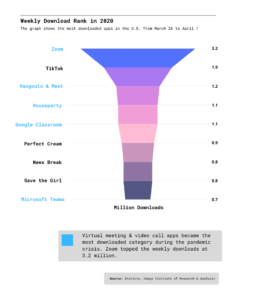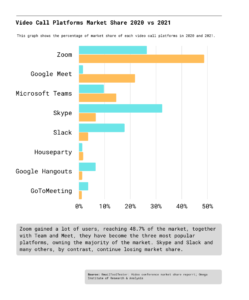- Industries
Industries
- Functions
Functions
- Insights
Insights
- Careers
Careers
- About Us
- Information Technology
- By Omega Team

Brief History
Virtual Meeting enhancement is a critical agenda for CEOs to improve efficiency, but as with many other technologies, the concept of video communication and conferencing was developed long ago, after the telephone was invented in the 1800s. It was a long trip from the first video call to Zoom meetings with a dozen people — and many steps between. AT&T and Bell Labs led the way toward video calls since they provided the only means of telecommunication for decades.
The rise of video conferencing started in the 1990s, with the internet entering the public domain. Polycom released SoundStation– a triangular speakerphone with high-quality audio that enabled both parties to simultaneously speak and be heard. Its first video product —— ShowStation — shipped in 1994.
Video conferencing capabilities were put into various scenarios from the early 2000s. The world’s first telesurgery took place in 2001. A team of French and American doctors in New York performed surgery on a patient in Strasbourg, France, using high-speed telecommunications technology and a surgical robot named Zeus. A few months later, the first live video broadcasting using satellite video was conducted during the war in Afghanistan.
Smartphone video conferences took off in 2010 with the introduction of iPhone 4 and FaceTime. With the tap of a button, you could go from a voice call to two-way video communication. Two important software programs were also initiated in the 2000s. Skype was introduced by three Estonian software engineers in 2003, and sold to Microsoft in 2011. It started out as a text messenger but expanded to add a video. WhatsApp was founded in 2009 as an instant messaging app. It did not include video chat until 2016 after it was bought by Facebook.
The Covid-19 lockdown forced a large percentage of Americans to work from home, and for their kids to attend school online. This led to a boom across the board for all video products, as many schools and businesses purchased video conferencing tools to keep people connected from home. Webex is the oldest of the bunch. It was formed in 1995, and Cisco Systems acquired it in 2007. It offered a comprehensive suite of products for business users, but in September 2020, Cisco launched a new platform — Webex Classrooms for virtual homerooms.
The top video conferencing platforms
From 2020, video call apps are being downloaded in large numbers to meet the needs of working at home and communicating with friends remotely. Among them, Zoom, Microsoft Teams and Google Meet stand out as the most popular platforms. Exhibits 1 and 2 show the download count and market share of these platforms.
Zoom takes the crown as the world’s most popular video conferencing platform. 44 countries, including Japan, the UK, the US, Canada, New Zealand, Russia, and South Korea all choose Zoom as their favorite platform. Microsoft teams have 41 countries favoring the video conferencing platform including Poland and the United Arab Emirates in which they hold a huge share of 41.91%. In third place, Google Meet rounds off the top 3 with being a favorite in 21 countries, ruling in countries like Italy and Denmark. Italy has a market share of 35.08%.
Exhibit 1: Weekly Download Rank in 2020

Exhibit 2: Video Call Platforms Market Share 2020 vs 2021

The global video conferencing market size is expected to reach USD 10.92 billion by 2027, exhibiting a CAGR of 9.7% during the forecast period. The market size stood at USD 5.32 billion in 2019. Zoom has observed a massive adoption rate with the lockdown. Zoom owns 49% of the global market share and has seen the most substantial year-on-year growth of all the platforms. Skype used to be one of the most popular platforms to communicate worldwide with people. With Zoom and Microsoft Teams growing in popularity, they saw a huge drop in global market share in the past year. They now only hold 7% of the market share.
AR & VR in Virtual Meeting
Immersive augmented reality (AR) and virtual reality (VR) are the trending technologies for the future of virtual meetings. AR provides an interactive and immersive experience that enhances real-world objects in your environment with added visual, auditory, haptic, somatosensory or even olfactory components. On the other hand, VR can simulate a completely different world or mimic real-world experiences.
AR and VR are applicable to any industry or business, including live entertainment, events, education and meetings. Surgeons are using AR and VR to practice highly technical surgeries; businesses can use them to provide virtual tours or to allow customers to test products and even car manufacturers are using them to give virtual lessons on how to repair your car.
After being cooped up inside due to the pandemic, people want further experiences instead of just watching. AR and VR can bring live experiences to virtual meetings. With AR & VR, audiences can learn about, explore and see things up close that they would otherwise have to travel far and wide for.
VR technology is being used to make virtual meetings more immersive and collaborative. The avatar system used in this software provides a realistic representation of the user in the virtual space. Images, documents, videos, and even 3D models can be displayed during a meeting. Availability is an important factor to consider while choosing VR meeting tools. Especially being accessible to non-VR users, since “VR headsets for everyone” is not always feasible.
How To Run Successful Virtual Meeting
Choose the Right Technology
Take time to review each platform carefully before you decide which one to use. For example, the most popular platforms Zoom, Microsoft Teams and Google Meet have different features, meeting sizes and time limits.Zoom is low-cost and very simple. You can easily access it from your laptop or mobile device. Its key features include the ability to host unlimited one-on-one meetings even with the free plan, meet with large groups, share your screen or audio, and even change your background to a custom virtual image. Registered users can host meetings with up to 100 people using the free version. You can also divide participants into different small groups and come back later easily. Zoom is ideal for hosting meetings, games and activities with virtual teams. Microsoft has the advantage that it is integrated into the workspace in Microsoft 365. You can do things like easily setting up a meeting with calendars, creating and sharing content, calling team members easily, and more. In terms of video conferencing, it has the ability to host calls with up to 10,000 members. Google Meet can handle up to 250 participants per call, live streaming for up to 100,000 viewers within a domain, and can record meetings on Google Drive for later broadcast, for paying G Suite subscribers. Google Meet can host gatherings of up to 250 participants, and also offers nifty additions like live captions and anti-abuse features. If data security is a priority for your business, then Meet is right for you, as long as everyone has a Google Account.
Technical Scaling
A virtual meeting’s success depends on the guidance of a facilitator. It is important to learn the skills and tools that you’ll need to succeed in the role of holding a meeting. Ice breakers can encourage everyone to relax and get acquainted before discussing business. Such team activities and games are often included in the platform. You need to be able to operate them effortlessly during the meeting. Make sure that you are completely comfortable with the software and rehearse the tools beforehand.Preparation
Virtual meetings may need more preparation than regular face-to-face ones. For example, how will you deal with conflict in this virtual space, and keep the discussion focused and on track? What if software difficulties prevent your most important team member from attending? Work some extra planning time into your schedule, so that you can prepare adequately both for the meeting itself and for any technical challenges that may occur.You should also be clear about the objective of the meeting. The invitation may include details such as agenda, list of attendees and start and finish times. Decide what you want to cover, and estimate how much time each item will take. Time is also important in virtual meetings. Be punctual with your start and finish times. Organize your information into 10 to 15-minute segments. This accommodates shorter attention spans and helps keep everyone engaged and focused.
Communication and Engagement
In face-to-face meetings, people pick up important cues from facial expressions, tone of voice, and body language. However, these are often lost in virtual meetings, which is why you need to take this into consideration when communicating with participants.One of the biggest challenges with virtual meetings is that participants can find it hard to get involved and contribute. Your job as the facilitator is to make sure that team members have plenty of opportunities to speak up. Keep everyone engaged by using activities and questions that require their participation. If people are engaged, they are less likely to get distracted, and you will retain their attention for longer.
SWOT Analysis for Virtual Meeting
Strength
Cost-effective and environmentally friendly
The service only requires a computer or mobile device with internet connection. Less travel means less spending on flights, accommodation, food, and catering. It’s no secret that travel, especially by air, is one of the significant contributors to global CO2 emissions. Opting to hold a virtual meeting instead of traveling is a proactive way to decrease a company’s carbon footprint.Short sessions and more frequency
When you meet in person, there is often a sense that you need to have a long meeting to make it worthwhile, while a virtual meeting can end as soon as you have discussed everything. Participants can go back to work immediately. You can also hold meetings more often conveniently with virtual meeting tools.Weakness
Fewer interactions and dynamic
It’s more challenging for all attendees to take an active role when the meeting is virtual, particularly when groups are large. In virtual meetings, it’s difficult to hear if more than one person is speaking. This can lead to an artificial feel from interactions.Internet and technological problems
To hold a video conference, all team members need a decent internet connection. A poor signal can lead to several things going wrong. Even worse, the entire conferencing software could fail and no one will be able to attend the meeting, although this is certainly rare.Opportunities
Increased Accessibility
Virtual meetings enable the sharing of ideas among wider audiences, increasing participation and contribution. It is easy to pick up a time that suits everyone, geographic location also will not be an issue anymore. Presenters can share their screens to the devices of all attendees, regardless of location. Without time and location restrictions, international representation can occur.Threats
Privacy and Security
Virtual meeting faces privacy and security threats. A study showed that it is relatively easy to collect thousands of publicly available images of video conference meetings and extract personal information about the participants, including their face images, age, gender, usernames, and sometimes even full names. This type of extracted data can vastly and easily jeopardize people’s security and privacy both in the online and real-world, affecting not only adults but also more vulnerable segments of society, such as young children and older adults.Conclusion
Virtual meetings have become a popular topic with the COVID-19 pandemic because most companies have been forced to move their meetings online, but at the same time, managers are beginning to realize the benefits of virtual meetings such as their efficiency and convenience. Making the best use of virtual meetings depends on how you choose the right platform, do your preparation, and communicate well during the meeting.
In addition, the application of AR and VR technology can make the virtual meeting experience more immersive and collaborative. Participants can present the same actions and operations in the virtual meeting as in the real world, and make the presentation of 3D models possible. These amazing technologies often don’t require you to own a pair of VR goggles and have more potential in the future.
Subscribe
Select topics and stay current with our latest insights
- Functions